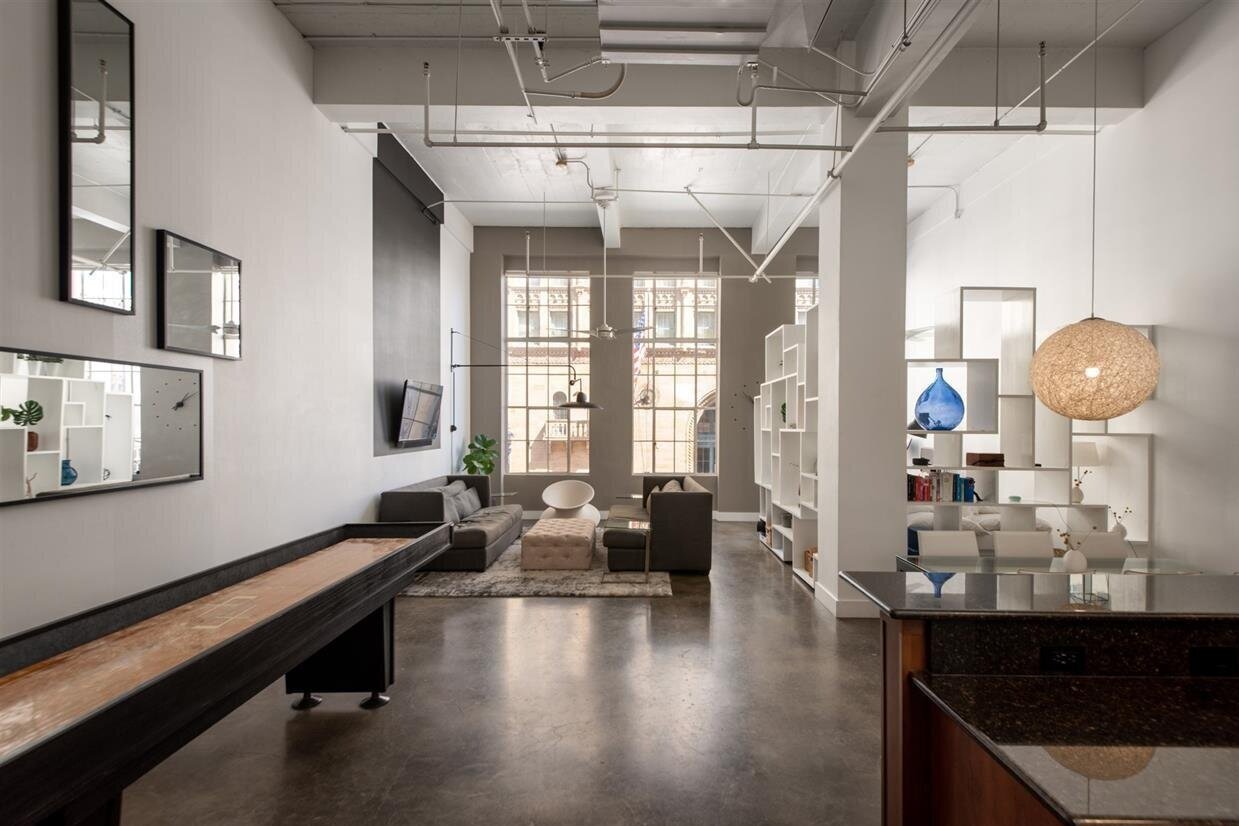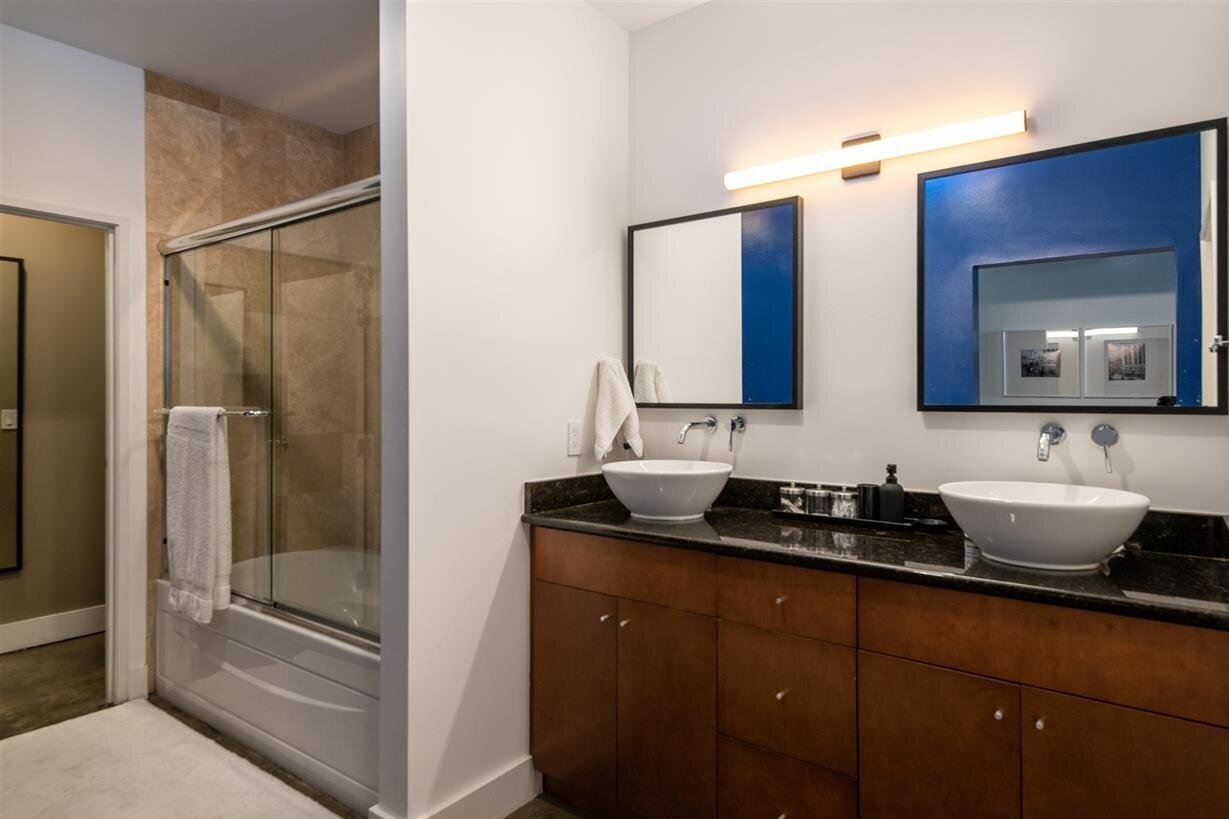Samuel Fox Lofts by William Templeton Johnson in Downtown San Diego’s Gaslamp District









The home: Rarely available loft in the historic Samuel Fox Building located in the Gaslamp District of Downtown. 12' windows and soaring 16' ceilings flood the unit with natural light. Polished concrete floors, custom cabinetry and exposed venting/ducts add to the industrial chic ambiance that is exuded from this amazing loft.
An expansive rooftop offers a bbq, outdoor sitting, cool breezes off the bay and tremendous views of downtown.
Being located in the heart of downtown, anything and everything you could want to do is within walking distance and waiting for you to enjoy.
Listing Courtesy of Scott Booth at Compass - 210008953
The building: Samuel Fox Building was built in 1929 by William Templeton Johnson, FAIA, to house Fox’s Lion Clothing Company. The price was $500,000 for the four-story, 56,000 square foot building. The Lion Clothing Company was the sole tenant until 1984. Today, the building is historic site number 72 and is home to the Samuel Fox Lofts. That is right, one can purchase a loft and live in this amazing building.
The architect: Born on Staten Island, New York, in 1877, Templeton Johnson was thrust into roofing work at the age of twelve when his father died. This sparked his interest in architecture, which he continued to pursue through his schooling at New York’s Columbia University and in Paris at the Ecole des Beaux-Arts from 1908 to 1911.
In 1905, he married Clara Delafield Sturges, whom he later divorced. They had three sons, Winthrop, Arthur, and Alan, and a daughter, Katherine. Clara, born in 1878, was no stranger to San Diego, having traveled to the Hotel Del Coronado for vacations with her family soon after the grand resort opened in 1888. She and Templeton came to San Diego in 1912 fresh from traveling through Europe after which Johnson began his practice. The six-foot-tall, blue-eyed, brown-haired Templeton Johnson became well known in the community; he was an avid tennis player and golfed with city benefactor George W. Marston, who would eventually make possible his most enduring commission, the Serra Museum in Presidio Park.
Clara Johnson’s most important contribution to progressive San Diego was her founding of the private, independent Francis W. Parker School in 1912, a school that William Templeton Johnson designed and where all four of their children received their elementary schooling. It was based on the philosophy of Chicago education reformer Colonel Francis W. Parker, and its curriculum put the child at the center of learning, stressed action over textbook learning, and attempted to foster responsible citizenship. The school was designed with a Spanish Mission flavor, and its central quadrangle and open-air classrooms with sliding doors were intended to adapt “the architecture to the educational aims.”
One of Johnson’s most notable early buildings in the Spanish Revival style was the La Jolla Public Library (now the La Jolla Athenaeum), dedicated in 1921. With the building’s roof tiles and smooth walls, the Spanish influence was evident, and its fanciful arches – their tops reminiscent of a seashell, a motif Johnson often used – had distinctly Moorish touches. Johnson’s commitment to indoor-outdoor living showed in his decision to leave “irregular corners and side spaces for flower beds,” natural touches that would finish off the building’s man made architecture.
Johnson helped create community on a larger scale in what some consider one of his greatest buildings: the Fine Arts Gallery in Balboa Park. For Johnson, “The erection of the Fine Arts Gallery at the head of the Plaza de Panama…gives the stamp of finality to the gradually evolving idea that Balboa Park is to be the center of the cultural and artistic life of the community.” Johnson also designed the Museum of Natural History in Balboa Park six years later, in 1932.
With the La Jolla Library, the Fine Arts Gallery, the 1928 San Diego Trust & Savings building at Sixth and Broadway and the Lion Clothing Company building, William Templeton Johnson built a local reputation in San Diego. His fame burgeoned into national recognition, however, when he won a competition against six other architects to design three buildings, one permanent and two temporary, to hold American exhibits at the Iberian-American Exposition in Seville, Spain, in 1929. That same year San Diego celebrated the opening of what would become Johnson’s most prominent work in San Diego – the Junipero Serra Museum.
Templeton and Clara Johnson divorced; she moved to New York with their daughter; the boys were in boarding schools and colleges. He married again in 1935, this time to Helen Hayes Gleason, a native of Cedar Rapids, Iowa, and a pianist. She went to work here for the American Red Cross programming recreational and social activities for patients in the U. S. Naval Hospital in Balboa Park.
In 1937 Johnson designed the main Post Office downtown on E Street between 7th and 8th. He contributed to the design of the new City and County of San Diego Administration Building. Johnson’s firm went on to design the San Diego Public Library; the nearly windowless administration building for Consolidated Vultee Aircraft (Convair), which is now the Port Authority building; three buildings and a master plan for development of San Diego State College.
Johnson died at the age of 80 in 1957, in the home he had designed in Mission Hills. A newspaper article about Johnson’s AIA fellowship in 1939 had described him as “always active in San Diego civic and cultural affairs,” and his 1957 obituary in a San Diego newspaper extolled him as “a cultural leader here since 1913.” His official posts included the presidencies of the Fine Arts Society and of the San Diego Chapter of the AIA; he was also a member of the City Planning Commission, the Park Commission, the Library Commission, the board of the San Diego Symphony Association, the University Club, the Cuyamaca Club, and the Executive Committee of the National Conference on City Planning. (Source: San Diego History Center).
